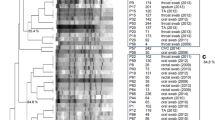Abstract
CHROMagar Candida (CHROMagar, France) was evaluated as a medium for the presumptive identification and isolation of yeasts using 1,537 isolates of medically important yeasts, including 970Candida albicans, 165Candida parapsilosis, 131Candida glabrata, 62Candida guilliermondii, 35Candida krusei, 32Candida tropicalis, 31Rhodotorula rubra, 23Trichosporon spp. (17Trichosporon beigelii), 17Candida famata, 16Candida pelliculosa, 10Pichia etchelsii, 10Saccharomyces cerevisiae, 8Candida lusitaniae, 7 Cryptococcus spp., and 20 isolates of otherCandida spp. After 48 h of incubation at 37°C, the sensitivity and specificity were, respectively, 99% and 100% forCandida albicans, 93.8% and 99.1 % forCandida tropicalis, and 100% and 100% forCandida krusei. In addition to colony color, other colony characteristics were important for identification of some species, such as rough colonies inCandida krusei isolates or the halo around the colonies ofCandida tropicalis. A great variety of colors was observed among species other thanCandida albicans, Candida tropicalis, andCandida krusei. For identification purposes, CHROMagar Candida medium has an accuracy similar to that of germ-tube tests and chlamydospore development tests forCandida albicans and to that of the ATB ID32C kit (API, bioMérieux, France) forCandida tropicalis andCandida krusei.
Similar content being viewed by others
References
Dupont B, Graybill JR, Armstrong D, Laroche R, Touzé E, Wheat LJ: Fungal infections in AIDS patients. Journal of Medical and Veterinary Mycology 1992, 30, Supplement 1: 19–28.
Walsh TJ, De Pauw B, Anaissie E, Martino P: Recent advances in the epidemiology, prevention and treatment of invasive fungal infections in neutropenic patients. Journal of Medical and Veterinary Mycology 1994, 32, Supplement 1: 33–51.
Rex JH, Rinaldi MG, Pfaller MA: Resistance ofCandida species to fluconazole. Antimicrobial Agents and Chemotherapy 1995, 39: 1–8.
Dupont B, Denning DW, Marriot D, Sugar A, Viviani MA, Sirisanthara T: Mycoses in AIDS patients. Journal of Medical and Veterinary Mycology 1994, 32, Supplement 1: 65–77.
McGinnis MR: Laboratory handbook of medical mycology. Academic Press, New York, 1980, p. 357–359.
Perry JL, Miller GR: Umbelliferyl-labelled galactosaminide as an aid in identification ofCandida albicans. Journal of Clinical Microbiology 1988, 25: 2424–2425.
Odds FC:Candida and candidosis. Bailliere Tindall, London, 1988, p. 62–67.
Martin MV, White FH: A microbiological and ultra-structural investigation of germ tube formation by oral strains ofCandida tropicalis. American Journal of Clinical Pathology 1981, 75: 671–676.
Nickerson WJ: Reduction of inorganic substances by yeasts. I. Extracellular reduction of sulfite by species ofCandida. Journal of Infectious Diseases 1953, 93: 45–56.
Pagano J, Levin DJ, Trejo W: Diagnostic medium for differentiation of species ofCandida. Antibiotic Annual 1957–1958: 137–143.
Costa SO, de Lourdes Branco C: Evaluation of a molybdenum culture medium as selective and differential for yeasts. Journal of Clinical Pathology and Bacteriology 1964, 87:428–431.
Lipperheide V, Andraka L, Ponton J, Quindós G: Evaluation of the Albicans ID® plate method for the rapid identification ofCandida albicans. Mycoses 1993, 36: 417–420.
MacKenzie DWR: Serum tube identification ofCandida albicans. Journal of Clinical Pathology 1962, 15: 563–565.
Quindós G, Fernández-Rodríguez M, Burgos A, Tellaetxe M, Cisterna R, Pontón J: Colony morphotype on Sabouraud-triphenyltetrazolium agar: a simple and inexpensive method forCandida subspecies discrimination. Journal of Clinical Microbiology 1992, 30: 2748–2752.
Goldschmidt MC, Fung DYC, Grant R, White J, Brown T: New aniline blue dye medium for rapid identification and isolation ofCandida albicans. Journal of Clinical Microbiology 1991, 29: 1095–1099.
Odds F, Bemaerts R: CHROMagar Candida, a new differential isolation medium for presumptive identification of clinically importantCandida species. Journal of Clinical Microbiology 1994, 12: 1923–1929.
Samaranayake YH, Wn PC, Samaranayake LP, So M, Ynen KY: Adhesion and colonization ofCandida krusei on host surfaces. Journal of Medical Microbiology 1994, 41:280–285.
Lipperheide V, Tellaetxe M, Latorre M, Ponton J, Quindós G: Caracterización fenotípica y sensibilidad a los antifúngicos de aislamientos clínicos deTrichosporon beigelii. Revista Iberoamericana de Micologia 1993, 10: 113–116.
Author information
Authors and Affiliations
Rights and permissions
About this article
Cite this article
San-Millán, R., Ribacoba, L., Pontón, J. et al. Evaluation of a commercial medium for identification ofCandida species. Eur. J. Clin. Microbiol. Infect. Dis. 15, 153–158 (1996). https://doi.org/10.1007/BF01591489
Issue Date:
DOI: https://doi.org/10.1007/BF01591489




